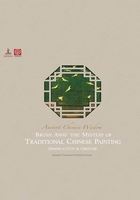
T型帛画 (tī xíng bó huà)
T-Shaped Painting on Silk
Zhang Yanyuan (815-907 AD), a renowned painter and art critic from the Tang Dynasty (618-907 AD), once said that traditional Chinese painting is all about lines.

➊ Heaven
The top horizontal section depicts Heaven and features several legendary figures from Chinese mythology, such as Nüwa, the Goddess who made man.
“Without lines, it won’t be a painting,” the art critic asserted.
Nearly all Chinese artists, ancient or contemporary, would probably agree.
The oldest Chinese paintings were nearly all composed of lines drawn on rocks, pottery, bronze ware and other handicrafts. And before Cai Lun (circa 61-121 AD) invented paper, Chinese artists also painted on another popular material in the country, namely, silk.
In April 1972, the painting on a T-shaped silk banner was unearthed from a 2,000-year-old tomb in southern China, shedding some new light on this special genre of Chinese painting and revealing the ethereal beauty of exquisite line drawing.
Archaeologists found the silk banner draped on an inner coffin in one of the tombs at Mawangdui near Changsha, capital of southern China’s Hunan Province. They were awed by the dazzling color and the fine and elegant lines used in drawing the beautiful painting on the banner.

Artist: Anonymous
Year: Han Dynasty (206 BC-220 AD)
Type: Ink and color on silk
Dimensions: 205 × 92 cm
Location: Hunan Provincial Museum, Changsha
Since then, the painting has been hailed by Chinese artists and art critics as one of the earliest masterpieces featuring gongbi zhongcai, or fine-brush with heavy color.
The banner is 205 cm long, 92 cm wide at top and 47.7 cm at bottom. It looks like an ancient Chinese dress with long sleeves.
The painting features motifs representative of the cosmos and afterlife. The top horizontal section depicts Heaven and features several legendary figures in Chinese mythology, such as Nüwa, the Goddess who made man and Chang’e, a lonely legendary woman who lives on the moon.

➋ Earth
The middle part represents the Earth and portrays the journey of the diseased into Heaven.
(Right) Archaeologists found the silk banner draped on an inner coffin in one of the tombs at Mawangdui in 1972.
The top part of the vertical section of the painting represents the Earth and portrays scenes of a funeral, with family members offering sacrifices to help the deceased on the journey to Heaven.
The bottom part of the vertical section illustrates the underworld with another legendary figure, Gun, a chieftain who once snuck into heaven and stole a lump of magic soil to stop a 22-year-long deluge on the Earth.
The painting also contains some chimerical creatures, such as dragons, divine leopards and those with human bodies and beast’s heads.
In addition to the legendary figures and creatures, there are also a number of real world animals and plants, such as cranes, swan geese, toads, rabbits and various trees.
Modern scholars and artists believe the painting was jointly created by several craftsmen with consummate painting skills. They say the composition, the brush drill and coloring of the painting demonstrate that Chinese brush painting had already reached a very high level in the early years of the Han Dynasty (206 BC-220 AD).
Artists at that time had not only mastered the traditional techniques of brush painting, but also invented a number of new ones. For instance: the exquisite line drawing and application of enriched colors.
The line drawing skill used in the painting later evolved into the so-called yousi miao or “silk thread drawing” technique, which was first employed by Gu Kaizhi (circa 345-406 AD), widely considered the father of classical Chinese figure painting.

➌ Underworld
The bottom illustrates the underworld, with another legendary figure, Gun, riding a mythological sea creature and holding a white platform which represents the Earth. Ancient Chinese believed the Earth was a flat piece of ground floating on the ocean.
The “silk thread” technique was widely used in the following centuries for drawing thin, smooth and flowing lines with classic suave elegance.
No wonder, the painting on the T-shaped silk banner is widely regarded by both art lovers and critics as a milestone in the development of traditional Chinese painting.
Today, the painting is a prized piece in the collection of the Hunan Provincial Museum in the southern China province where it was discovered more than four decades ago.